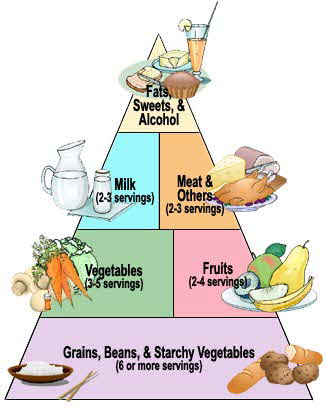EATING HEALTHY AND STAYING FIT TO CONTROL AND MANAGE DIABETESWhat is diabetes and are you at risk?Diabetes is a disease that results in too much sugar (glucose) in the blood. Your body does not have enough insulin available to turn food into energy. High levels of glucose slowly damage your eyes, heart, kidneys, nerves, legs, and feet. Diabetes is a serious disease affecting 20.8 million people in this country, and you may be at risk if you are Hispanic, overweight, or do not exercise regularly. Hispanics are nearly twice as likely as non-Hispanic whites to develop this disease.
Steps to healthy eating and a healthy lifestyle to control and manage diabetes:• Begin with a healthy eating plan. Healthy eating means eating more grains, fruits, and vegetables, and less meat, sweets, and fats every day. "Let the Food be the Medicine and Medicine be the Food" (Hippocrates).
• Be physically active every day to help prevent weight gain and improve blood sugar control.
• Check the sugar in your blood and take your medication every day if needed.
How to create a healthy meal plan:
To create a healthy meal plan you should do the following:• Eat a variety of foods as recommended in the Diabetes Food Pyramid to get a balanced intake of the nutrients your body needs - carbohydrates, proteins, fats, vitamins, and minerals.
• Make changes gradually because it takes time to accomplish lasting goals.
• Reduce the amount of fat you eat by choosing fewer high-fat foods and cooking with less fat.
• Eat more fiber by eating at least 5 servings of fruits and vegetables every day.
• Eat fewer foods that are high in sugar like fruit juices, fruit-flavored drinks, sodas, and tea or coffee sweetened with sugar.
• Use less salt in cooking and at the table. Eat fewer foods that are high in salt, like canned and packaged soups, pickles, and processed meats.
• Eat smaller portions and never skip meals.
• Learn about the right serving sizes for you.
• Learn how to read food labels.
• Limit use of alcohol.
What is the Diabetes Food Pyramid?The Diabetes Food Pyramid is a general guide of what and how much to eat each day. It is similar to the Food Pyramid you see on many food packages. The pyramid is divided into six groups. You should eat more foods from the largest group at the base of the pyramid and less from the smaller groups at the top of the pyramid. The number of servings needed every day is not the same for everyone, so a range of servings is given to ensure you get the foods you need for good health. The food groups and suggested servings per day are listed below.  • Grains, Beans, and Starchy Vegetables: (good source of B vitamins and fiber) 6 or more servings/day
• Fruits: (contain vitamins C, A, potassium, folate, and fiber) 3-4 servings/day
• Vegetables: (provide vitamins A, C, folate, and fiber) 3-5 servings/day
• Milk: (source of calcium, protein, vitamins A and D) 2-3 servings/day
• Meats and Others: (good source of iron, zinc, B vitamins, and protein) 2-3 servings/day
• Fats, Sweets, and Alcohol: The foods at the tip of the pyramid should be eaten in small amounts. Fats and oils should be limited because they are high in calories. Sweets are high in sugar and should only be eaten once in a while. What is the right number of servings for you?The Diabetes Food Pyramid gives a range of servings for each group, but it is only a guide. If you have diabetes, a dietitian can design a specific meal plan for you.
Remember that the number of servings listed is for the entire day. Since food raises blood sugar levels, it is best to space servings throughout the day. For example, 4 servings of fruit might be divided between 3 meals and 1 snack. Keep in mindFollow a healthy lifestyle, eat healthy foods, and keep physically active to help control diabetes. If you have diabetes, be an active member of your diabetes care team: you, your doctor, dietitian, and other health care providers. This meal planner gives you only general information. Consult with your diabetes care team. What is a serving size in the Food Pyramid?Each of the following represents one serving from each of the food groups in the Diabetes Food Pyramid: • Grains, Beans, and Starchy Vegetables:
1 slice of bread; 1/2 small bagel, English muffin, or bun; 1/2 cup cooked cereal, pasta, rice; 3/4 cup ready-to-eat cereal; 1/2 cup cooked dried beans, corn, peas
• Vegetable Group:
1 cup raw vegetable; 1/2 cup vegetable juice
• Fruit Group:
1 medium-size fresh fruit; 1/2 cup canned fruit; 1/2 cup fruit juice
• Milk Group:
1 cup (8 ounces) milk or yogurt
• Meat Group:
2-3 ounces cooked lean meat, skinless poultry, or fish; 1 egg; 2 tablespoons peanut butter; 2-3 ounces cheese
• Fats, Sweets, and Alcohol:
1 teaspoon butter, margarine, or mayonnaise; 1 tablespoon cream cheese or salad dressing; 1 tablespoon cream cheese; 1/2 cup ice cream.
Your own Meal Plan:If you have diabetes, consult a registered dietitian to help you make your own meal plan. Your meal plan will be based on many factors, including your weight goal, height, age, and physical activity.
National Diabetes Education Program (NDEP) ndep.nih.gov
NIDDK, National Institutes of Health
| 